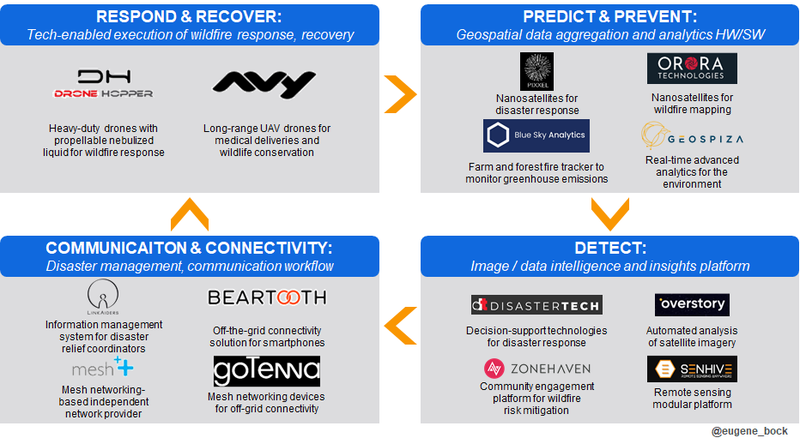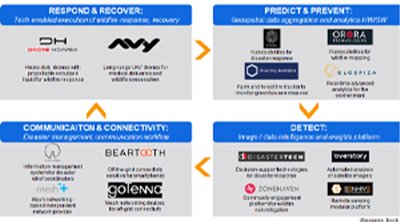Dissecting the wildfire response workflow through the lens of ventures
Not every fire is bad — in fact, prescribed and managed fires are necessary for proper forest management. They create the black-and-green checkerboard across the forest and serve as natural dampers to lower the fire intensity when flames do occur in dry conditions. The “good” fires, therefore, are an effective one-step-backward-for-two-steps-forward approach in disaster management.
However, the reality is that this is much easier said than done. Whereas a natural wildfire is categorized as an emergency, unlocking hazard pay for firefighters and allowing for relaxed regulations for efficient management of the fires, planned burns are human-made events that are subject to much more stringent environmental compliance rules. There is also inherent incentive misalignment in that the fire departments will not bear the consequences of deciding not to light, but will certainly be penalized if they intentionally start the fire, and something unfortunately goes awry.
This post focuses on the “bad” fires, and how best to prevent, detect, and respond to those. Fortunately, the venture ecosystem is rich with start-ups leveraging a number of emerging technologies to solve for this piece of the puzzle. Below is my current interpretation of the overall cycle of wildfire management along with a few ventures that hone in on different aspects of the workflow.

Wildfire Response Venture Landscape
1. Predict & Prevent
Like most unfortunate events, the best way to deal with them is preventing them from ever happening. In the case of wildfire prevention, continuous monitoring and analyses of geospatial data and satellite imageries over time are often utilized to identify early signals for at-risk regions. An illustrative example within the venture ecosystem is Pixxel, which specializes in providing a unique layer of overall situational awareness by developing their own proprietary hyperspectral nanosatellites with increased speed and resolution of imageries.
These granular images, then, can be further processed along with other data points across air, humidity, wind and ground data to derive insights on imminent climate risk exposure and inform forestry management departments . Orora Technologies, Geospiza and Blue Sky Analytics all offer pointed solutions with each focused on disaster management, climate risk assessment, and air quality analyses, respectively. As investors, we’re encouraged to find a healthy balance of ventures prioritizing both high quality imagery aggregation and multi-variable-based risk assessment tools to best inform and evaluate imminent risk profiles.
In fact, our view is that these two categories will converge over time and consolidate into a few players that can provide the best quality data along with the most granular insights. From an individual venture perspective, we’ve discovered DisasterTech, Overstory, a couple of the exemplary ventures that solve for the data processing and visualization side of the equation. Similarly, Senhive through its Sen-Eye product adds AI and edge-computing-powered HW device to monitor designated terrain and provide alerts within minutes of fire outbreaks with additional speed and precision. Zonehaven is also an interesting solution that focuses on the community engagement aspect of the response to promote public safety preparedness by providing live evacuation updates and coordinating communication between fire, law, and EMS.
2. Detect
This segment of the workflow entails early detection of a fire outbreak and is a natural extension of the first part of the workflow. At the end of the day, the analytics platform can only be as strong as the quality of data inputs, and a logical business model extension of the data aggregators is a dashboard-like analytics and visualization platform.
In fact, our view is that these two categories will converge over time and consolidate into a few players that can provide the best quality data along with the most granular insights. From an individual venture perspective, we’ve discovered DisasterTech, Overstory, a couple of the exemplary ventures that solve for the data processing and visualization side of the equation. Similarly, Senhive through its Sen-Eye product adds AI and edge-computing-powered HW device to monitor designated terrain and provide alerts within minutes of fire outbreaks with additional speed and precision. Zonehaven is also an interesting solution that focuses on the community engagement aspect of the response to promote public safety preparedness by providing live evacuation updates and coordinating communication between fire, law, and EMS.
3. Communication & Connectivity
After the wildfires have been detected, the next critical step of the workflow is coordinating the first response team to most effectively put out the fires, and the enablers here are the communication and connectivity solution providers to help the first responders execute at scene.
At the responder-to-responder level, there are tools like GoTenna and BearTooth that allow for off-grid communication as a hedge against lost limited connectivity in certain regions. Currently, the immediate use cases of these products are designed for consumers, but we anticipate there will be analogous versions designed for responder use cases, whether from these ventures or others.
In terms of connectivity, ventures like LinkAiders and Mesh++ provide additional layers of infrastructural security for connectivity (disclosure: TechNexus is an investor in Mesh++ through one of our corporate partnerships). In the future, as more emerging technologies (like GoTenna and BearTooth) seep into the core responder workflow, there will be an increasing need to ensure a strong and secure connectivity at-scene, and these ventures provide that independent backhaul as an alternative option to power those technologies.
4. Respond & Recover
The last piece of the puzzle is execution. Given 25%+ of U.S. Forest Service fire suppression today spending is dedicated to planes and helicopters used to put out fire, ventures like Drone Hopper and Avy focus on putting out the fire and providing delivery of medical apparatus for timely and effective response. As the drone space continues to mature, we will not only see more generic drones that run on electricity autonomously that deliver our Amazon goods and pizzas, but also drones that cater to first response use cases.
There’s limited resources to manage fires, whether “good” or “bad.” Hopefully this provides a glimpse into how best to deal with the bad ones, so we can allocate more towards planning the good ones in the future. Lastly, if you’re a venture tackling one or many of the workflows around wildfire response (whether featured in this landscape or not), I’d love to chat — eugene@technexus.com!
